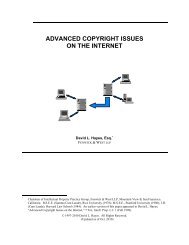Paramount Pictures Corporation v. ReplayTV, Inc., Joint Stipulation ...
Paramount Pictures Corporation v. ReplayTV, Inc., Joint Stipulation ...
Paramount Pictures Corporation v. ReplayTV, Inc., Joint Stipulation ...
You also want an ePaper? Increase the reach of your titles
YUMPU automatically turns print PDFs into web optimized ePapers that Google loves.
12345678910111213141516171819202122232425262728attempt to obtain competitively sensitive information. See Request Nos. 7-8, 16.Plaintiffs also demand production of individualized communications with investorsand analysts (Request Nos. 27-28, Disney Interrogatory Nos. 11-12), even thoughDefendants have agreed to produce all standardized communications with thesepeople.Plaintiffs’ assertion of relevance for revenues or other financial benefitsattributable in any way to the <strong>ReplayTV</strong> 4000, as well as every singlecommunication Defendants have ever had with any actual or potential investor,rests on their fundamental mischaracterization of the type of “ financial benefit” thatmust be present before vicarious liability can be imposed on a defendant. In fact, tosupport a claim of vicarious liability, financial benefit must be directly attributableto the alleged infringement of the plaintiff’ s work(s). Plaintiffs ignore this wellestablishedrule and argue that any financial benefit realized by Defendants, even ifdirectly attributable to non-infringing uses of the <strong>ReplayTV</strong> 4000, is somehowrelevant to the “ financial benefit prong” of vicarious liability. Plaintiffs’ position isutterly meritless. The law is clear that neither an indirect financial benefit nor oneattributable to a non-infringing activity is relevant to this inquiry.1. The Legal Standard For Vicarious Liability Makes Irrelevant AnyFinancial Benefit That Is Not Directly Attributable To The AllegedlyInfringing Conduct.Liability for vicarious infringement will only be imposed where: (1) thedefendant has the right and ability to control the direct infringer (the “ control”prong); and (2) the infringement provides a “ direct financial benefit” to thedefendant (the “ financial benefit” prong). Adobe Systems <strong>Inc</strong>. v. CanusProductions, <strong>Inc</strong>., 173 F. Supp. 2d 1044, 1048 (C.D. Cal. 2001) (Pregerson, J.);Fonovisa, <strong>Inc</strong>. v. Cherry Auction, <strong>Inc</strong>., 76 F.3d 259, 262-263 (9th Cir. 1996).The financial benefit prong has generally required a showing that thedefendant received a share of the revenues specifically derived from the79
















